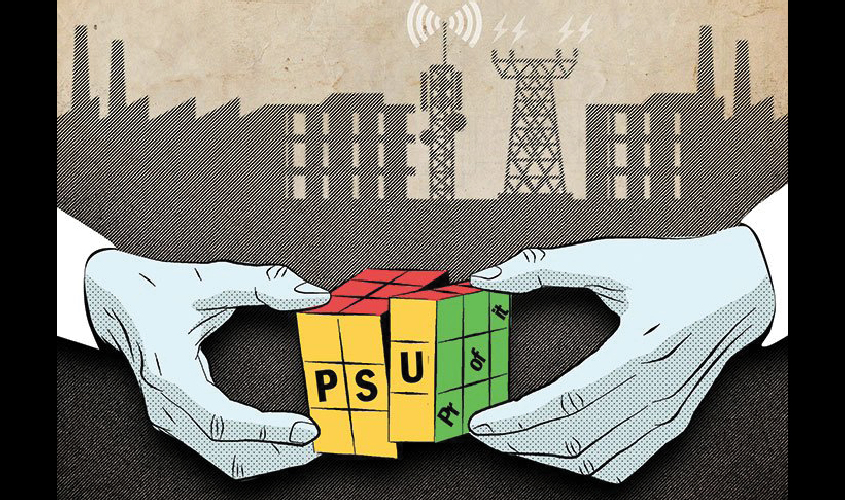It seems that the incumbent regime is uncomfortable with the D-word.
We don’t slaughter cows, Arun Shourie once said, we starve them to death. The disinvestment minister in the Atal Behari Vajpayee government knew it too well. For public sector undertakings (PSUs) are the biggest holy cows of the country, many of which are dying a slow death; Air India is one example. But no slaughter or sale.
The real and ultimate victim is the taxpayer, forsaken by the political class. For, politicians care only about holy cows.
Even holier are the shibboleths of the pre-liberalisation era, held by politicians and intellectuals close to their hearts. Unless these shibboleths are fought against and demolished, it is very difficult, if not impossible, to sell PSUs—indeed to carry out any meaningful reform.
Privatisation is the most meaningful and substantive economic reform. For it is the concretisation of the idea that the business of government is not business—something that Narendra Modi had famously spelt out as Chief Minister of Gujarat (it has not been followed since he became Prime Minister, though). When government sells a PSU, it rolls itself back from a sector, lets private enterprise take care of the sold entity, and reduces its own role in the economy.
Privatisation is also the boldest and most emblematic reform, as it hits at the most visible entities of socialism—state-run companies that are supposed to stay at the commanding heights of the economy. Therefore, privatisation cannot be carried out in a technocratic manner: a body of experts recommending it, and bureaucrats and financial professionals executing it.
Unfortunately, this was the path chosen by the Modi regime for disinvestment in Air India and other PSUs. Niti Aayog, headed by the Prime Minister, prepared a list of PSUs to be privatised, leaving the execution to ministries. What was ignored was the fact that before selling PSUs to private parties, the very idea of privatisation has to be sold politically and ideologically.
When Vajpayee was Prime Minister (1998-2004), a department of disinvestment was set up; it was later upgraded to a ministry. Arun Jaitley was the first disinvestment minister but he was there for a short period in which he sold Modern Food to Hindustan Lever.
Shourie succeeded him. Beginning with Balco, which was sold to Sterlite, he successfully privatised a number of PSUs, both profitable and loss-making. These included several ITDC hotels, Hindustan Zinc, Indian Petrochemicals Corporation Ltd, and Maruti. There was tremendous resistance to the sale of these state-run companies, and it came from all quarters—the managements and workforce of the targeted PSUs, the administrative ministries, political parties including the ruling party, the Sangh Parivar, trade unions, intellectuals, sundry activists, professional revolutionaries, et al.
Shourie and others forcefully argued in favour of privatisation; they offered economic and moral arguments to justify their actions; they made a case for the sale of PSUs.
That was then. In 2004, the Congress-led United Progress Alliance (UPA) formed government with outside support from the Left Front. Needless to say, the commies were rabidly opposed to disinvestment. Communist Party of India general secretary A.B. Bardhan triggered bloodshed on Dalal Street by infamously saying in May 2004, “Bhaad mein jaaye disinvestment (Let disinvestment be damned).”
Disinvestment has been damned since then; even Modi, seen as a pro-liberalisation leader earlier, has been unable to revive it. To begin with, the UPA government officially downgraded it; the ministry of disinvestment was reduced to department of disinvestment and brought under the Finance Ministry.
In a way, the Modi regime went a step further—in the wrong direction. It even dispensed with the D-word; the department of disinvestment was renamed as the Department of Investment & Public Asset Management or Dipam; it was an assault on assault, and yet it was in tune with the Prime Minister’s penchant for evocative acronyms. Comrade Bardhan would have applauded. But the point is: how can you carry out disinvestment if you are scared of or uncomfortable with the very word itself?
It seems that the incumbent regime is not just uncomfortable with the D-word but also at odds with the very philosophy and economics it connotes. How could the government, so devoted to dirigisme, let go of the “national carrier”? How could it allow a private company to run the airline that has been “national pride” for so long? This was the reason that tough conditions were imposed on the prospective buyer of Air India.
So, the government wanted to hold 24% stake in the airline after privatisation. It also insisted on the retention of not just employees but also the brand name “Air India”. The political environment was hostile to the sale of AI which, to boot, is heavily debt-ridden. Besides, the employees are unionised and unions have political links. The negatives were so many and so substantive that no private party could garner courage to bid for Air India.
So, Air India will continue to bleed the taxpayer for an indefinite period. Meanwhile the big holy cow, Air India, will fade into irrelevance. Just like MTNL, BSNL, public sector banks, scores of other PSUs.

